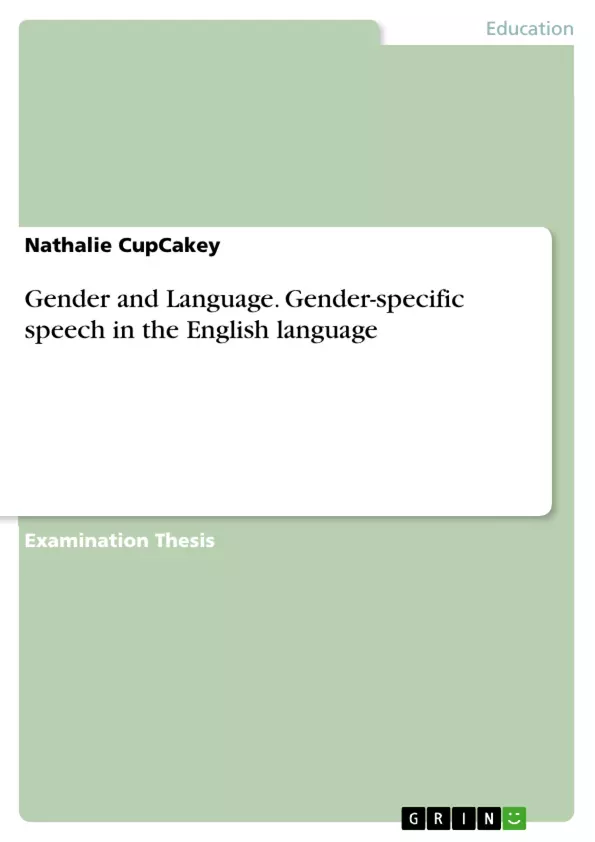Gender-specific speech in the English language
Apparently women talk three times as much as men. This is something one half of the population has long suspected while the other half always vocally denied it. But what about the contents? Men and women are also believed to be unable to communicate, so do they really share the same language? Some say that this is not just a myth. It is a common belief that there lies truth in these legends of having different ways of expressing one's wants and needs. People have always been interested in the topic but since the late 20s century literature on the topic has started blooming. It is not only books that kept appearing and ended up on the best-seller lists, but also seminars were advertised, as well as telephone helplines and even dating websites are not a taboo anymore, all of them with the common aim of helping genders sort out their misunderstandings.
In this paper I will focus on aspects and more precisely the differences in male and female talk to show how analysing speech acts can reveal hidden truths about the genders and their communication habits.
As Deborah Cameron states in her book (2009) it is still a matter of research to know where the origins of language lie. At the same time arises the question of gender-related particularities within the language used by both sex. The latter also entails various theorists to argue upon the origin of language as originated in men (case bolstered by e.g. Crow,1998), while others believe that it first appeared in women (e.g. Dunbar,1996). Cameron also explains how language serves the purpose of creating and maintaining the cohesion within a social group. Therefore she refers to Robin Dunbar, who says that linguistic exchange plays the same role as grooming does for primates. With the increase in size of pre-historic human groups, language became necessary in order to exchange information and improve relationships between the members of the group. Language was born.
Henceforth throughout history, language has evolved and can be analysed according to two categories: one which focusses on male language, the other one on female language.
Inhaltsverzeichnis (Table of Contents)
- Gender-specific speech in the English language
- Vocabulary
- Vulgar Language
- Communication Habits
- The Politics of Language
Zielsetzung und Themenschwerpunkte (Objectives and Key Themes)
This paper aims to analyze the differences in male and female speech patterns in the English language, revealing insights into gendered communication habits. By examining speech acts, the paper explores the historical and contemporary perspectives on gendered language use.
- Gendered language use in English
- The influence of historical and contemporary perspectives on gender and language
- The impact of gendered communication on social dynamics and power structures
- The role of biological factors in shaping gendered speech patterns
- The implications of gendered communication for various aspects of society, such as politics and the job market
Zusammenfassung der Kapitel (Chapter Summaries)
The first chapter discusses the origins of language, contrasting theories that attribute its genesis to men or women. The chapter explores the role of language in social cohesion and explores the historical notion of men being the dominant force in language development. The second chapter examines the evolution of vocabulary and its use in different genders, highlighting the prevalence of sexist views in 18th and 19th-century English society. The third chapter delves into the realm of vulgar language, examining the stereotype of women as being more polite in their speech compared to men. The fourth chapter explores the differences in communication styles between men and women, emphasizing the notion of women excelling in verbal tasks and men in visual-spatial tasks. The chapter also discusses the implications of these differences on social dynamics, such as the perception of male-female miscommunication and its impact on issues like rape and the job market. The fifth chapter focuses on the political arena, examining the underrepresentation of women in politics, especially in the context of the British House of Commons. The chapter highlights the potential role of gendered communication in shaping political discourse and the need for women to assert themselves more forcefully.
Schlüsselwörter (Keywords)
This paper explores the complexities of gender-specific speech in the English language, focusing on key themes such as: language and gender, communication styles, male-female miscommunication, historical perspectives on gendered language, sexism, social dynamics, power structures, biological factors, vocabulary, vulgar language, political discourse, and the underrepresentation of women in politics.
- Arbeit zitieren
- Nathalie CupCakey (Autor:in), 2012, Gender and Language. Gender-specific speech in the English language, München, GRIN Verlag, https://www.hausarbeiten.de/document/212388


